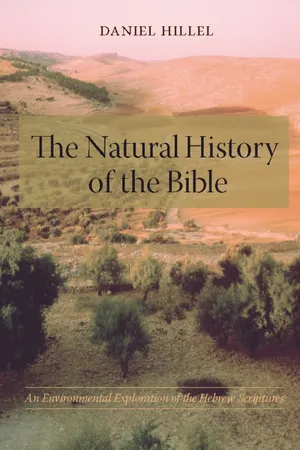
The Natural History of the Bible
An Environmental Exploration of the Hebrew Scriptures
- English
- ePUB (mobile friendly)
- Available on iOS & Android
The Natural History of the Bible
An Environmental Exploration of the Hebrew Scriptures
About this book
Traversing river valleys, steppes, deserts, rain-fed forests, farmlands, and seacoasts, the early Israelites experienced all the contrasting ecological domains of the ancient Near East. As they grew from a nomadic clan to become a nation-state in Canaan, they interacted with indigenous societies of the region, absorbed selective elements of their cultures, and integrated them into a radically new culture of their own. Daniel Hillel reveals the interplay between the culture of the Israelites and the environments within which it evolved. More than just affecting their material existence, the region's ecology influenced their views of creation and the creator, their conception of humanity's role on Earth, their own distinctive identity and destiny, and their ethics.
In The Natural History of the Bible, Hillel shows how the eclectic experiences of the Israelites shaped their perception of the overarching unity governing nature's varied manifestations. Where other societies idolized disparate and capricious forces of nature, the Israelites discerned essential harmony and higher moral purpose. Inspired by visionary prophets, they looked to a singular, omnipresent, omnipotent force of nature mandating justice and compassion in human affairs. Monotheism was promoted as state policy and centralized in the Temple of Jerusalem. After it was destroyed and the people were exiled, a collection of scrolls distilling the nation's memories and spiritual quest served as the focus of faith in its stead.
A prominent environmental scientist who surveyed Israel's land and water resources and has worked on agricultural development projects throughout the region, Daniel Hillel is a uniquely qualified expert on the natural history of the lands of the Bible. Combining his scientific work with a passionate, life-long study of the Bible, Hillel offers new perspectives on biblical views of the environment and the origin of ethical monotheism as an outgrowth of the Israelites' internalized experiences.
Frequently asked questions
- Essential is ideal for learners and professionals who enjoy exploring a wide range of subjects. Access the Essential Library with 800,000+ trusted titles and best-sellers across business, personal growth, and the humanities. Includes unlimited reading time and Standard Read Aloud voice.
- Complete: Perfect for advanced learners and researchers needing full, unrestricted access. Unlock 1.4M+ books across hundreds of subjects, including academic and specialized titles. The Complete Plan also includes advanced features like Premium Read Aloud and Research Assistant.
Please note we cannot support devices running on iOS 13 and Android 7 or earlier. Learn more about using the app.
Information
Table of contents
- Cover
- Half title
- Title
- Copyright
- Dedication
- Contents
- Acknowledgments
- A Note on Translation
- Chronology
- Prologue: A Personal Testament
- 1. Environment and Culture: A Premise and Its Implications
- 2. The Ecological Context: A Region of Disparate Domains
- 3. The First Riverine Domain: Influence of Mesopotamia
- 4. The Pastoral Domain: Legacy of the Bedouin Patriarchs
- 5. The Second Riverine Domain: Sojourn and Slavery in Egypt
- 6. The Desert Domain: Wanderings in Sinai and the Negev
- 7. The Rainfed Domain: Settlement in the Hill District of Canaan
- 8. The Maritime Domain: Interactions with Philistines and Phoenicians
- 9. The Urban Domain: Convergence of King and Cult in Jerusalem
- 10. The Exile Domain: Expulsion, Survival, Revival, and Return
- 11. The Overarching Unity: Culmination of Ethical Monotheism
- Epilogue: The Lasting Relevance of Early Ecological Influences
- Appendixes
- Notes
- Bibliography
- Permissions and Credits
- Index